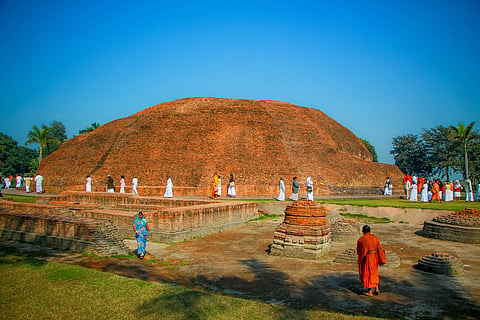
- Destinations
- Experiences
- Stay
- What's new
- Celebrating People
- Responsible Tourism
- CampaignsCampaigns
- Subscribe
- Buy Now

Uttar Pradesh is home to many spiritual locations and no we are not talking about Varanasi. Here are the spiritual towns in UP that you may include in your journey to find meaning of life.
It is a familiar Indian motif - a temple town embraced by a river and a string of ghats. The town of Bateshwar, not far from Agra (70 km), is exactly that. And yet its relative anonymity has meant that it has retained its character with fewer tourists and more pilgrims, especially during its annual winter cattle fair - 2,000 years old and second only to Bihar's Sonepur Mela in size. This spiritual town's name has been derived from the Bateshwarnath Temple that is dedicated to Lord Shiva. According to a legend, it was here under a Banyan tree that Shiva took rest for a while and so this place came to be known as Bat-Ishwar or the Banyan lord. Of the 40-odd temples that still stand here by the Yamuna, many are unique and vary in splendour, size and vintage, some dating back to the 15th century. Dedicated to Shiva, the crumbling edifices are awaiting restoration.
When to go: October to March
Nearest airport: Agra
Nearest rail: Shikohabad, Agra
Think Buddhist circuit and you'll come up with Bodhgaya, Nalanda, Sarnath and Sanchi. But often overlooked is Kushinagar, the Buddha's final resting place. This humble town in eastern Uttar Pradesh was the capital of the ancient kingdom of Malla. It was a lost world for over 500 years before its chance rediscovery in the mid-19th century. Although several impressive new Buddhist temples have altered the town's landscape, its main draws remain the historic stupas and viharas dating to the 3rd century BCE. Among these, the Mahaparinirvana Stupa and temple (the latter houses a stunning 1,500-year-old reclining Buddha) and the Muktabandhan Stupa (representing the Buddha's cremation site) are the most spectacular.
When to go: October-March
Nearest airport: Gorakhpur
Nearest rail: Gorakhpur, 52 km away, is a convenient railhead other than small station Deoria Sadar
Sardhana is famous for its beautiful basilica, built in 1822 and dedicated to the Virgin Mary and her miraculous cures. A couple of hours' drive out of Delhi, close to Meerut, the town hosts a nine-day pilgrimage every November. The church has an interesting history behind it. Listen to locals tell the tale of the Muslim dancing girl who rose to become a Christian princess Begum Samru married Walter Rheinhardt, a French mercenary, fought by his side, inherited his fiefdom of Sardhana and his six battalions and personally led her troops in battle. She also played a minor role in political dealings with the Mughals, the Marathas as well as the British. After adopting Christianity as her religion, she went on to commission the beautiful church at Sardhana.
In a town as small as Sardhana, the church dwarfs everything around it. As you enter the town, however, notice the Islamic-style monuments that make up the Catholic graveyard. Now under the Archaeological Department, this graveyard's ground contains the remains of many people who were connected to Begum Samru. Visitors are required to park outside the church compound, as cars are not allowed in. The walk to the church is lined with marble statues depicting the crucifixion and resurrection of Christ. The complex is quite large, with mango groves on both sides and a convent school for girls as well. The first view you get of the church, from the gates, is a side one. This is because altars in Catholic churches are built so that the priest and people face the rising sun.
An Italian architect by the name of Anthony Reghelini was commissioned to build this basilica. Doric columns line the verandah that runs around the church. The three domes you will see are replicas of the ones at St PeThe Basilica of St. Peter in Rome is a notable landmark. The steeple on the left side of the basilica has two bells, while the one on the right used to have a clock that was removed when it became worn out. Adjacent to the altar, there is a wing that houses the tomb of Begum Samru. This monument, created by Italian sculptor Adamo Tadolini, is made of marble. The six figures standing below the tomb are purely symbolic, while the others represent individuals who were connected to Begum Samru, such as her minister. Begum Samru herself is depicted sitting on top of the monument, holding a scroll from the Mughal emperor Shah Alam II, which grants her the jagir of Sardhana. Take a moment to enjoy the peaceful atmosphere as you explore the entire complex. There are also several other buildings in close proximity to the basilica, including St. John's Seminary, which was formerly Begum Samru's palace, Lady Forester's Hospital, and a house constructed for the basilica's architect.
When to go: October-March
Nearest airport: Delhi
Nearest rail: Daurala, Meerut
